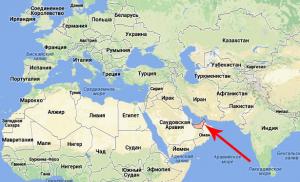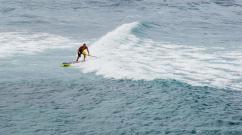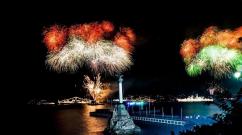Great Lakes of North America (USA and Canada): photos, videos, where the great American lakes are located on the map. Satellite map of lakes All lakes on the physical map of the world
Map of Lakes from satellite. Explore the satellite map of the Lakes online in real time. A detailed map of the Lakes was created based on satellite images high resolution. As close as possible, the satellite map of the Lakes allows you to study in detail the streets, individual houses and attractions of the Lakes. The Lakes map from the satellite can easily be switched to regular map mode (diagram).
Ozery is a city located in, on the banks of the Oka. In the distant times of the 16th century, on the site of the modern city there was the village of Ozerki, as evidenced by references in the scribe book. In the mid-19th century the village became a village. The development of the textile industry begins, the population grows. In 1925, Ozery received the title of city.
The modern city of Ozyory attracts attention with its unique pristine natural beauty. In the vicinity of the city, coniferous and mixed forests grow; small rivers, ponds and lakes can be seen here in large numbers.
Vacationers come to Ozyory with their entire families from May to September. Amateur fishermen will not be left without a catch; fish are found in abundance in these waters. The forests are rich in mushrooms and berries, and a well-maintained city beach awaits those who want to splash in the water and sunbathe. Aeroclubs offer their visitors paragliding and parachute jumping. In winter, you can ski in Ozery and breathe clean forest air. Boarding houses and sanatoriums will help restore health.
The city has a well-developed infrastructure, there are enterprises such as a confectionery plant, a mechanical plant, an optical glass plant, and the production of industrial refrigerators has been established. Local newspapers are published, Radio Ozery and local television broadcast.
Among the attractions are the “Nagornaya oak grove” (a natural monument), excavations of an ancient settlement, the Trinity Church, and the local history museum.
The largest system of freshwater lakes in the USA and Canada is represented by 5 closely interconnected huge reservoirs, which occupy an area of 245 thousand km2 (water volume 23 thousand km3). The lakes are located in a stepwise order from Lake Superior to Lakes Huron, Michigan, Erie, Ontario, descending to the Atlantic, and interconnected by a network of small rivers and straits.
See where the Great American Lakes are located on the world map:
Sorry, the card is temporarily unavailable
The most majestic, deepest, coldest and largest of the Great Lakes North America Lake Superior is considered. With harsh, almost untouched shores, it amazes with its size - 85 thousand km2 and depth - up to 406 m. Lake Superior is famous for its tough temperament; in stormy weather, the height of its waves can reach 12 meters. The northern coast has a particularly inaccessible view, where steep slopes are covered with pine forests and lichens.

The second largest among the Great Lakes of the United States and Canada is Lake Huron. It differs from its fellows in its unusual coastline. The northern part of Huron is rocky, with steep banks, separated from the main part by Manitoulin Island. There are many rocky islets, cliffs and volcanoes in Georgian Bay. In the southern part of the bay the shore is represented sandy beaches. In some places you can see 300-meter-high limestone cliffs, the so-called “Blue Mountains”. The lake covers an area of 59 thousand km2, depth - 228 m.


Lake Michigan will connect to the island. Huron is a wide strait, over which rises the longest bridge in the world (8 km). The outlines of the shores of the reservoir are rectilinear. The northern part is wild and uninhabited. The southern part of the coast is densely populated (Chicago). The area of the third largest reservoir of the Great Lakes of North America is 58 thousand km, depth is 281 m.




Lake Erie is surrounded by more picturesque scenery, enlivened by numerous national parks and nature reserves. Point - Pele Nature Reserve is one of unique places on the continent, where vast swamps with a peculiar fauna have been preserved. The southeastern and northern shores are flat and sandy. The southern coast is densely populated, with large industrial cities in the USA: Cleveland, Toledo, Buffalo. The northern Canadian coast is less populated. The full-flowing Niagara River flows from Lake Erie, on which the 48-meter Niagara Falls are formed. The area of Lake Michigan is 58 thousand km2, maximum depth is 281 m.

Lake Ontario is the smallest lake in the Great Lakes system. Its area is only 19 thousand km2, but it is quite deep (maximum depth 244 m). The banks are low and flat, covered in places with deciduous forest. Pointed rocks are common in the southeast. On the northern Canadian coast are located major cities: Toronto, Hamilton, Ottawa. The region has many national parks in the United States and Canada. From the lake flows the St. Lawrence River, which carries the flow from the Great Lakes to the Atlantic.




On the interactive map of lakes Russian Federation lakes are indicated, descriptions of which are in our catalog of lakes in Russia.
On the territory of the Russian Federation there are more than 2 million lakes, the total area of which is more than 350 thousand square kilometers (not taking into account the Caspian Sea-lake). The amount of lake water reserves is 26 thousand square kilometers. The main part of the lakes is of glacial origin. The largest lakes in the European part of the Russian Federation (mainly located in the northwestern part) are Ladoga (area - 17,680 square kilometers), Onega (area - 9,720 square kilometers), Chudsko-Pskovskoye (area - 3,550 square kilometers), Ilmen (area - 1000 square kilometers), as well as Vygozero, Topozero and other lakes of Karelia. The largest lake in Siberia and Russia is Baikal - the most deep lake all over the world. It is in Baikal that 85 percent of the lake water of all Russia and 22 percent of reserves are concentrated fresh water all over the world. The length of Baikal is 636 kilometers with an average width of 48 kilometers, with a total area of 31.7 thousand square kilometers and a maximum depth of 1620 meters. At the same time, most of the lakes located on the territory of Russia are classified as small - a huge number of lakes are located in the northwestern part of the European part of the Russian Federation and on the territory of the West Siberian Plain. Among all the lakes, fresh lakes predominate, but there are also salty ones, the largest of which is Lake Chany, which is located in the southwestern part of Siberia.
It is worth noting that only on our website is there interactive map all lakes that are located on the territory of the Russian Federation with the corresponding coordinates, descriptions, characteristic features and much more. It is no secret that you can easily find many different maps on the Internet. However, all these maps are purely regional in nature. When working with our map, you can select the desired region. We have the ability to zoom and search on the map for the desired lake. This mainly helps to find out the exact location of a particular object and study the road leading to it. All lakes on the map are indicated by special icons, by hovering over them you can see a picture of the lake. This is also a distinctive feature of our map from others. It should be noted that our map also helps beginners who want to go on vacation or fishing for the first time to a particular body of water - the road is well marked, especially on a large scale. Happy fishing on the lakes of Russia!
There are more than two million freshwater and salt lakes in Russia. The largest lakes in the European part of the country include Ladoga (17.87 thousand km²) and Onega (9.72 thousand km²) in the north-west, Lake Peipus (3.55 thousand km²) on the Estonian border, as well as the Rybinsk Reservoir ( 4.58 thousand km²) on the Volga north of Moscow.
Narrow lakes from 160 to 320 km in length, located behind dams on the Don, Volga and Kama. In Siberia, similar artificial lakes are located on the upper Yenisei and its tributary the Angara, where the 570 km long Bratsk reservoir is one of the largest in the world. But they are all insignificant compared to Lake Baikal, the largest reservoir of fresh water on the planet. 636 km long and with an average width of 50 km, Baikal's surface area is 31.72 thousand km² and its maximum depth is 1642 m.
There are also countless smaller lakes, located mainly in the poorly drained lowlands of the Russian and West Siberian Plains, especially in the more northern regions. Some of them reach significant sizes, in particular, Lake Beloe (1.29 thousand km²), Topozero (0.98 thousand km²), Vygozero (0.56 thousand km²) and Lake Ilmen (0.98 thousand km²) on the territory of the European north-west of the country, and Lake Chany (1.4-2 thousand km²) in south-west Siberia.
List of the largest lakes in Russia
We present to your attention the 10 largest lakes in the Russian Federation with descriptions, photos and geographical location on the map of the country.
Caspian Sea

The Caspian Sea is the world's largest inland body of water (area: 371 thousand km²). It is called a sea, not a lake, because the ancient Romans, who arrived in this region, discovered that its water was salty, and called it a sea after the Caspian tribes who lived near the shores of the lake. The Caspian Sea borders the following five countries: Russia, Kazakhstan, Turkmenistan, Azerbaijan and Iran. The main river feeding the lake is the Volga, which provides about 80% of the water inflow of the Caspian Sea, and the remaining 20% comes from other smaller rivers.
The Caspian Sea is rich in oil and natural gas deposits, but their extraction is under development. The extraction process is also hampered by the problem of separation natural resources lakes between the five countries bordering it. The Caspian Sea and the deltas of the rivers flowing into it are home to about 160 species and subspecies of fish from 60 genera. About 62% of species are endemic.
Baikal


Baikal is the deepest (1642 m), oldest (25-35 million years) and most voluminous (23.6 thousand km³) of all the lakes in the world, it is a superstar reservoir in the fields of hydrology, geology, ecology and history. Today Lake Baikal contains about 20 percent of the fresh water on the Earth's surface, which is comparable in volume to the entire Amazon River basin. Baikal has 27 islands, including one more than 70 km in length (Olkhon Island).
The shores of the lake are home to more than 1,500 species of animals, 80% of which are found nowhere else on the planet. The most famous representative of the Baikal fauna is the seal, which lives exclusively in fresh water. According to some reports, the population of seals is about 100,000 individuals. Also near the lake there are such large predators as wolves, which occupy the top positions of the Siberian food chain, feeding on deer, birds, rodents and smaller predators.
Lake Ladoga


Lake Ladoga is the largest freshwater lake Europe, located in northwestern Russia, 40 km east of St. Petersburg. The area of the lake is 17.87 thousand km², the volume is 838 km³, and the maximum depth at a point west of the island of Valaam it reaches 230 m.
The lake depression appeared under the influence of glaciers. The northern shores are mostly high and rocky, and are separated by deep, ice-covered bays. Southern Shores have many sandy or rocky beaches, mostly low, slightly concave, overgrown with willow and alder. In some places there are ancient coastal embankments covered with pine trees. The largest tributaries are the Volkhov, Svir and Vuoksa rivers.
48 different species of fish were found in the lake, of which the most common are roach, carp, bream, pike perch, perch and smelt. Of the 48 species, 25 are of commercial importance and 11 are classified as important food fish.
Lake Ladoga also serves as a key stopover for migratory birds along the North Atlantic Flyway, which typically mark the arrival of spring.
Lake Onega


Lake Onega is the second largest lake in Europe, located in the north-west of the European part of Russia, between Lake Ladoga and the White Sea. It covers an area of 9.72 thousand km², 248 km in length and up to 83 km in width. The greatest depth is about 127 m.
The lake basin was formed by the movement of the earth's crust and glaciers. The high rocky shores in the north and northwest are composed of laminated granite and covered with forest. There are deep bays in Petrozavodsk, Kondopoga and Pevenets. The southern shores are narrow, sandy, often swampy or flooded. Lake Onega has about 1,650 islands, covering a total of about 260 km², usually in the northern and northwestern bays.
The lake is home to more than 40 species of fish, including vendace (a small member of the salmon family), smelt, burbot bream, pike, perch, roach and salmon. Many fish species have significant economic value.
Taimyr


Taimyr is the second (after Baikal) largest lake in the Asian part of Russia, located in the central regions of the Taimyr Peninsula. It is located south of the Byrranga Mountains, in the zone.
The lake and tundra area is a popular destination for birds such as geese, swans, ducks, ruffed buzzards, peregrine falcons and snowy owls. Lives in Lake Taimyr large number fish, including grayling, muksun, char and whitefish. Although the area is relatively remote, stocks of certain commercial fish species are still being depleted.
Taimyr is famous for the largest population of reindeer in Eurasia. Animals such as argali, arctic fox, wolf and lemmings are also found in this region. In 1975, the area was reintroduced.
The lake and its surroundings have been included in the Taimyr Nature Reserve since 1983. Scientists have discovered plutonium in the lake sediment, which is believed to have entered Taimyr via wind-blown radioactive particles from nuclear tests conducted on Novaya Zemlya during the Cold War.
Khanka


Lake Khanka has an area of 4 thousand km², of which approximately 97% is located in Russia. The maximum depth of the lake is 10.6 m, and the average volume is 18.3 km². The lake is fed by 23 rivers, 8 of which are in China, and the rest in the Russian Federation. The only outflow is the Sungacha River, which flows east to the Ussuri River, which forms the international border, and flows north where it joins the Amur River.
Khanka is famous for being home to the highest diversity of birds in the entire temperate zone of Eurasia. At least 327 species of nesting, wintering and migratory birds have been observed in the lake area.
Lake Peipus-Pskov


Lake Peipus-Pskov is the largest transboundary and fifth (after Ladoga, Onega, Swedish Vänern and Finnish Saimaa) largest lake in Europe, located on the border between Estonia and Russia. It occupies 3.6% of the total area of the Baltic Sea basin. A total of 30 islands are located on Lake Peipus, and another 40 in the delta of the Velikaya River. Most of them rise only 1-2 m above the water level, and often suffer from floods.
About 54 species of coastal aquatic plants grow in the Lake Peipus basin, including reeds, calamus, reeds and various grasses. The waters of the lake are home to 42 species of fish, such as smelt, vendace, bream, perch, pike, roach and whitefish. Wetlands provide important nesting and feeding grounds for migratory birds such as swans, geese and ducks that migrate from the White Sea to the Baltic Sea. The region is home to one of the largest swallow colonies in Estonia.
Uvsu-Nur


Uvsu-Nur is the largest lake in Mongolia in terms of surface area (3.35 thousand km²), as well as the largest salt lake in the country. The Uvs-Nur basin is one of the most important biodiversity poles in Eurasia. Although most of the lake is in Mongolia, its northeastern shores are located in the Tyva Republic of the Russian Federation.
The lake is shallow, very salty, and is the remnant big sea that existed several thousand years ago. The basin covers an area of about 70 thousand km² and is one of the best preserved natural steppe landscapes on the continent. It is here that the northernmost part of the desert and the most southern part tundra
Reed and freshwater river deltas serve as resting and nesting sites for numerous migratory birds. More than 220 species of birds can be found around the lake, including black stork, osprey, white-tailed eagle, whooper and black-headed gull. About 29 different species of fish live in the waters of the lake, one of which is suitable for human consumption. Mountain region serves as a home to Mongolian gerbils, wild sheep and Siberian ibex.
Vats


Although Lake Chany is not very well known outside of Siberia, it is one of the most large lakes countries. Chany is a shallow lake with salty and constantly fluctuating water, the level of which can change from season to season and from year to year. The lands of the lake basin serve as pastures for cattle.
In terms of area, Beloe is second (after Onega) natural lake Vologda region, and third (after the Rybinsk reservoir). It is one of the ten largest natural lakes in Europe. The lake has a relatively round shape with a diameter of 46 km. Its area is 1.29 thousand km², and the basin area is about 14 thousand km².
The lake is famous for its fish stocks, the most famous delicacy being Belozersk smelt. The food supply and high oxygen levels create favorable conditions for the life of many species. The following types of fish are common in the waters of the lake: perch, pike, bream, ruffe, sabrefish, roach, bleak, burbot, chub, rudd, whitefish, ide, tench, asp, dace and gudgeon).
Table of the 10 largest lakes in Russia
| Lake name | Area, km² | Volume, km³ | Dimensions, km | Maximum depth, m | Average depth, m |
| Caspian Sea | 371000 | 78200 | 1200 by 435 | 1025 | 208 |
| Baikal | 31722 | 23615 | 636 by 79.5 | 1642 | 744,4 |
| Lake Ladoga | 17870 | 838 | 219 by 125 | 230 | 46,9 |
| Lake Onega | 9720 | 285 | 248 by 83 | 127 | 30 |
| Taimyr | 4560 | 12,8 | - | 26 | 2,8 |
| Khanka | 4070 | 18,3 | 90 to 45 | 10,6 | 4,5 |
| Lake Peipus-Pskov | 3555 | 25 | width 50 | 15 | 7,1 |
| Uvsu-Nur | 3350 | 35,7 | 85 to 80 | 20 | 10,1 |
| Vats | 1400-2000 | - | 91 to 88 | 7 | 2,1 |
| White Lake | 1290 | 5,2 | 46 by 33 | 20 | 4 |
Great lakes- a group of five lakes in eastern North America on the US border with Canada; the largest group of freshwater bodies on Earth. 2/3 of the water area is located in the United States, and 1/3 is in Canada. The lakes are connected to each other by a series of rivers and straits. They are included in the 1000 popular attractions of the world according to our website.
The formation of these reservoirs began more than 10 thousand years ago as a result of tectonic processes. Total area The water system has about 768 thousand km². The largest and deepest is Lake Superior. It has a border location: partly located in Ontario (on the Canadian side) and partly in Minnesota (on the United States side). Along the St. Marys River it merges with neighboring Huron, which is inferior in size by almost 20 thousand km².
The water in Verkhny is so cool that even in summer it does not warm up to more than 4 ºC. It contains a lot of commercial fish. The third body of water in the system is Lake Michigan. Unlike its “brothers”, it falls entirely within the territory of the United States. Ontario is considered to be the smallest lake in the system. With an area of just under 20 thousand km², it is the 14th largest source of fresh water in the world. It is connected to the ocean through the St. Lawrence River. It is a navigable lake with many port cities. Another lake, the fourth largest, is Erie.
All lakes in this system are home to trout, sturgeon, whitefish and other fish species - more than 170 species in total. Coastal cities include Toronto, Chicago, Michigan, Buffalo, etc. Along the entire perimeter of the reservoirs, the shipping area is developed, both for passenger and cargo transportation. The climate in the vicinity of the lakes is moderately humid with characteristic atmospheric changes. Best season for boat trips - autumn or the so-called “Indian summer”.
Photo attraction: Great Lakes
Great lakes. Lake Superior
Great lakes. Lake Michigan
Great lakes. Lake Huron
Great Lakes on the map:
The world around us 4th grade
Seas, lakes and rivers of Russia
The shores of Russia are washed by the seas of the Arctic, Pacific, and Atlantic oceans. The largest lakes in Russia are the Caspian Sea, Baikal, Ladoga, Onega. The largest rivers are the Volga, Ob, Yenisei, Lena, Amur.
Using the map in the textbook, label the outline map ( The world around us 4th grade, p. 30-31):
option 1 - Russian seas;
option 2 - lakes and rivers of Russia. 
Ask a student sitting next to you to check your work.
Use the map in your textbook to determine which oceans the seas listed below belong to. Please note using the following notation:
Seas of the Arctic Ocean— Barents Sea, Chukchi Sea, Laptev Sea, Kara Sea, White Sea, East Siberian Sea
Seas Pacific Ocean
— Sea of Okhotsk, Sea of Japan, Bering Sea
Seas of the Atlantic Ocean— Baltic Sea, Black Sea, Azov Sea

Our inquisitive Parrot considers himself the best geography expert in the world. Here are some of his statements. Are they true? Circle "Yes" or "No".
Great Lakes of North America on the map
If not, write the correct answer.
a) The most big lake world - the Caspian Sea. Answer: YES
b) The deepest lake in the world is Ladoga. Answer: NO Baikal
c) The largest lake in Europe is Onega. Answer: NO Ladoga
d) Lake Onega and Lake Ladoga are connected by the Svir River. Answer: YES
e) From Lake Ladoga The Neva River flows out, on which St. Petersburg stands. Answer: YES
This is the task Seryozha and Nadya offer you. The names of the largest rivers in Russia are “hidden” among these letters. Find them and fill them in with different colored pencils.

Using the map in the textbook, determine which rivers these cities are located on. Connect the names of cities and rivers with lines.

Cross out the excess geographical name in every listing. Explain (verbally) your decision.
a) Baltic Sea, Caspian Sea, White Sea, Okhotsk Sea. The Caspian Sea is a lake, all other seas
b) Volga, Ob, Baikal. Lena. Baikal is a lake, everything else is rivers
c) Baikal, Ladoga, Onego, Svir. The Svir is a river, everything else is lakes.













